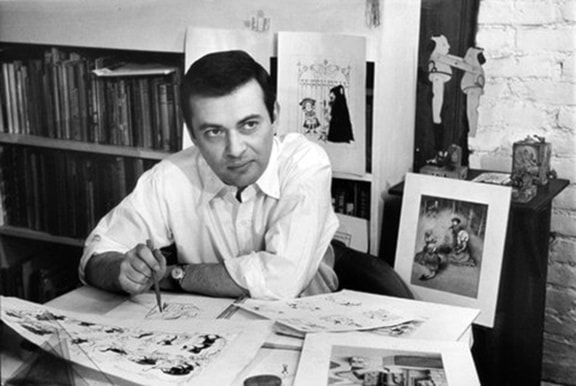Mike Selby
'Kenny's Window,' 'Very Far Away,' 'The Sign on Rosie's Door' and 'The Nutshell Library' were the very first books Maurice Sendak had published; all delightfully illustrated but fairly typical children's books. It wasn't until his fifth book, 'Where the Wild Things Are,' that Sendak would be propelled to international fame and recognized as "the most important children's book artist of the 20th century."
The money earned from 'Where the Wild Things Are' enabled Sendak to engage in his lifelong passion of book collecting. He was a serious collector of his favourite author Herman Melville, and began to purchase any and all first editions, gift editions, handwritten notes and manuscripts that he could find. In 1966 he walked into the Rosenbach Museum & Library in Philadelphia, hearing that they housed not only works by Melville, but books owned by him, stored in Melville's own bookcase.
The Rosenbach Museum became Sendak's favourite place, and he soon began to deposit his own work and original illustrations there. He joined their board of trustees in 1973, and after 40 years in this role was named the board's honorary president, as well as having a newly built wing of the museum named after him.
Sendak passed away in 2012, days before his 84th birthday. While generations of readers mourned his passing ('Goosebumps' author R.L. Stine stated it was "a sad day in children's books and for the world), a legal battle broke out over Sendak's books.
Since the late 1960s, Sendak had been placing not only the books he wrote and illustrated, but also the books he collected over his lifetime, at the Rosenbach Museum. At the time of his death, the Rosenbach owned just a little over 10,000 of them. And "owned" is the key word, as a protracted legal feud between the Rosenbach and Sendak's estate quickly ignited.
Now the museum argued that Sendak's intention was clear by his very action of depositing his collection with them, over the 40 years he was on the board of trustees. By doing so, Sendak made his work and work he owned available to any and all visitors and researchers. Not only does the museum have an entire wing named after him, but they have put on 70 different shows of his work.
This seems fairly cut and dry except for the pesky fact that Sendak (who had no heirs) left a will stating that his 10,000 books be given to a foundation set up in his name, to curated at a museum bearing his name near his hometown of Ridgefield, Connecticut. According to the lawyers for his estate, his wishes are clearly stated in his will.
"Clearly" is a bit of a stretch here, because — although Sendak wanted his legacy to be housed in his hometown — his will also stated that the rarest of his rare books be gifted to the Rosenbach. Just what exactly constitutes the rarest of the rare has been part of this drawn-out legal battle. Extremely rare editions of both Beatrix Potter and William Blake would appear to be exactly what Sendak intended the museum to keep, except his estate hotly debates this point, believing the Potter books are children's books and therefore not rare (?), and that the Blake books aren't even books (original illustrated manuscripts).
Finally, After four long years of legal debate, the probate judge finally issued a ruling on November 1.
The court stood by Sendak's will, awarding the bulk of the 10,000 items to his estate, while the Rosenbach gets to keep the rare editions, including all the Potter and Blake books.
So ... the majority of Sendak's works have been removed from the Rosenbach Museum, and transferred to the museum bearing his name in Ridgefield. All well and good except that no such place currently exists. It appears his estate had been so busy suing the Rosenbach Museum that carrying out Sendak's wishes may have been overlooked. They did create a foundation for the establishment of a museum, but exactly just what type of museum (public, private, research) has yet to be determined. The city of Ridgefield has tentatively approved two proposed sites, but much more still needs to be done. It will take millions and millions of dollars to create, something which neither the city, nor the Sendak foundation, currently has.
For now, in what numerous critics call "Where the Wild Things Aren't," 10,000 Maurice Senak items sit in a Connecticut storage facility, waiting to be curated in a museum which at best is anywhere from five to eight years away.
Mike Selby is Reference Librarian at the Cranbrook Public Library
